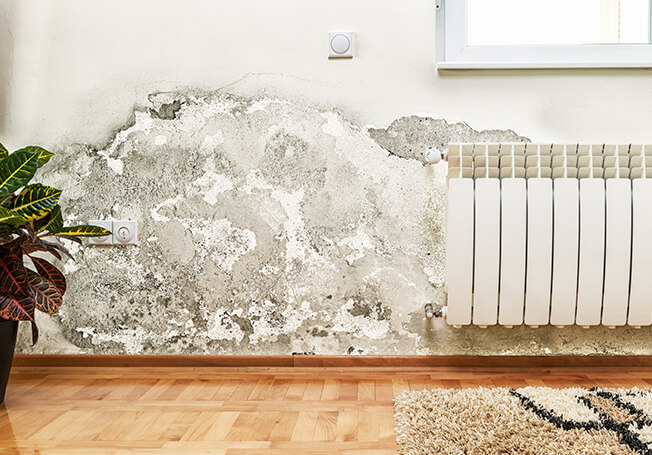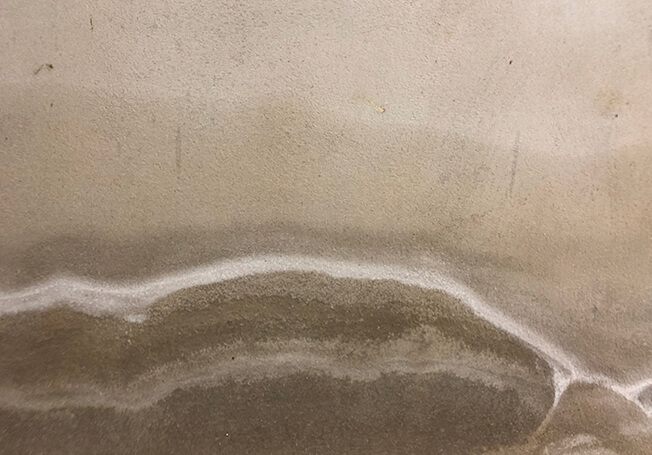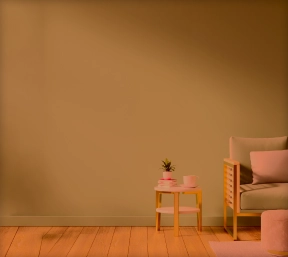TRENDING
Concrete efflorescence
Waterproofing efflorescence
Efflorescence: A Problem That Requires an Expert Damp Proof Solution - Blogs Asian Paints
Returning to the safe and familiar atmosphere of your beloved home after a long day at work evokes an indescribable sense of comfort. Your home goes beyond being a mere shelter; it becomes an extension of your private life, a sanctuary where you find solace and cultivate meaningful connections with loved ones.
The dream of a beautiful home with well-painted walls, excellent ventilation, and a warm, welcoming ambiance is universal and well-deserved. However, inadequate waterproofing can mar the appearance and atmosphere of your living space, leading to issues like dampness and peeling paint. One of the most dreaded problems associated with poor waterproofing is efflorescence on walls, an unwelcome occurrence that can significantly impact the aesthetics and structural integrity of your home.

WHAT IS EFFLORESCENCE?
Efflorescence refers to the formation of a powdery or crystalline deposit on or underneath the surface of various types of masonry. The deposit is usually an unappealing shade of white, brown, gray, or yellow and mars the aesthetic appeal of the walls.
Efflorescence on walls results when water present in the building surfaces dissolves certain salts and migrates to other areas, leaving behind salty deposits as it evaporates. It is among the most challenging waterproofing problems to solve. Unfortunately, efflorescence cleaning is a major problem when it comes to concrete surfaces.
Concrete efflorescence can be triggered by faulty waterproofing, humidity, rain, and condensation. While exterior efflorescence is tricky enough, treating interior efflorescence is considered even more challenging.
Common Causes Of Efflorescence:
- The presence of certain salts in the construction materials used
- Improper raising of masonry following repointing
- Incomplete hydration process/improper curing of concrete
- Improper flashing or caulking
- Excessive water added to the concrete
- Improper drainage
- Inadequate provisions for ventilation
- Sulfation of pyrites in clay
- Improper ground storage
Two Kinds of Efflorescence
1. Primary Efflorescence
This type of efflorescence occurs when concrete is in the curing phase. If water with soluble salts or lime emerges to the surface and evaporates, leaving a powdery residue, it is known as primary efflorescence.
2. Secondary Efflorescence
Secondary efflorescence occurs after the concrete has hardened. When external moisture migrates to a concrete surface and infiltrates it causing the appearance of powdery deposits, it is known as secondary efflorescence.
The problems posed by efflorescence on walls aren’t just aesthetic. Left untreated, it can lead to structural damage as well. While there are many traditional methods for efflorescence cleaning, these are seldom effective.
HOW TO SPOT EFFLORESCENCE
Efflorescence can be a frustrating issue for property owners, affecting brick, concrete, and cement surfaces. It occurs when soluble salts, present in building materials, are drawn to the surface through moisture migration. If left untreated, it can lead to unsightly white, powdery deposits on walls and structures, compromising their aesthetics and structural integrity. To address efflorescence promptly and effectively, it's crucial to spot it early on. Here are some pointers to help you identify efflorescence:
- White, Powdery Deposits: The most evident sign of efflorescence is the appearance of white, chalky deposits on the surface of walls or other structures. These deposits are usually more noticeable after rain or periods of high humidity when moisture brings the salts to the surface.
- Discoloration and Stains: Efflorescence can cause discoloration and staining on the affected surfaces. As water evaporates, it leaves behind salt deposits, leading to unsightly marks on the brick, concrete, or cement.
- Crusty Residue: When you touch the affected area, you may notice a crusty texture caused by the accumulation of salts on the surface. The residue can be easily scraped off, but it may reappear if the underlying issue is not addressed.
- Damp or Moist Walls: Efflorescence is often associated with areas that experience moisture intrusion or water seepage. If you notice damp or moist walls, especially in basements or areas exposed to water, efflorescence may be a probable culprit.
WHAT ARE THE CONVENTIONAL METHODS OF TREATING EFFLORESCENCE AND WHY ARE THEY INEFFECTIVE?
There are many conventional ways of treating efflorescence, but none of them are truly effective. Let us take a look.
1. Cleaning With Water
Applying a forceful water rinse to efflorescence with a pressure washer to clean it up is a widely used method. However, using water can bring more salt to the surface, and there is a risk of efflorescence resurfacing.
2. Using a Stiff Brush
Traditionally, stiff brushes are used to sweep away efflorescence from smoother surfaces. However, this method is just a temporary solution as it doesn’t treat the root cause of the problem.
3. Using Chemical Cleaners
A mild solution of muriatic acid in water is a conventional chemical cleaner used for clearing efflorescence. While this may clear up efflorescence, it can also lead to erosion of masonry if not done properly.
4. Applying Diluted Vinegar
People who don’t want to use chemical cleaners often resort to applying diluted vinegar to efflorescence. While this method may work in the short run, it is ineffective in the long haul.
5. Sandblasting
Sandblasting is another common method of efflorescence cleaning. Even though it does remove efflorescence, it is an abrasive method that erodes the wall surface.
6. Chemical Waterproofing
Mix waterproofing chemicals with cement and apply them to the affected areas. This solution may perform temporarily but fails in the long run due to a lack of flexibility in the coating, consequently leaving room for cracks to develop owing to contraction/expansion.

HOW ASIAN PAINTS SMARTCARE HELPS FIGHT AGAINST EFFLORESCENCE?
Traditional methods of treating efflorescence are mostly ineffective because they try to fix the problem after it occurs. Asian Paints SmartCare products help eliminate any chances of efflorescence by tackling the root cause of the issue.
SmartCare Damp Block 2K is a high-performance coating used for both positive and negative side waterproofing. With excellent bonding, good waterproofing, and unmatched resistance to hydrostatic pressure, it provides lasting protection against efflorescence and safeguards concrete from carbonation. Apply two coats on brick walls that are prone to damage from efflorescence. This product comes with a 3-year warranty on the brick level.
Another excellent way of protecting your home from efflorescence is to apply two coats of SmartCare Ultra Block 2K to any masonry surfaces, bricks, or concrete walls that are subject to damage from high moisture. This product comes with a 4-years warranty when applied at the brick level. Other than treating efflorescence, Ultra Block 2k & Damp Block 2k can also be used for waterproofing bathroom sunken areas, water tanks, and roofs.
Efflorescence is extremely common and it's difficult to treat it. Most of the conventional ways of fighting efflorescence are either downright ineffective or may lead to some other issues. That is why it is important to fight efflorescence the right way with Asian Paints SmartCare waterproofing products to maintain the strength and beauty of your home.
Want Hassle-free Painting? Think Asian Paints Beautiful Home Painting
FAQs
1. What is the efflorescence of Concrete?
Efflorescence in concrete refers to the formation of white, powdery deposits on the surface of concrete structures. It occurs when water-soluble salts present in the concrete mix are carried to the surface by moisture. As the water evaporates, these salts are left behind, leading to visible crystalline deposits. Efflorescence in concrete can mar the appearance of structures and may indicate issues with water infiltration or drainage problems. Proper waterproofing and drainage measures are essential to mitigate the occurrence of efflorescence on walls and other concrete surfaces.
2. What is the efflorescence of bricks?
Efflorescence in bricks is a similar phenomenon to that in concrete. It involves the migration of water-soluble salts to the surface of bricks through capillary action. When the water evaporates, the salts crystallize, leaving behind a whitish, salty residue on the brick's surface. Efflorescence in bricks can be particularly noticeable, affecting the aesthetic appeal of walls and masonry work. Preventive measures such as proper ventilation, waterproofing membrane application, and addressing water leakage issues are crucial to minimize and manage the occurrence of efflorescence in cement and brickwork.
3. What is efflorescence in cement?
Efflorescence in cement refers to the appearance of white, chalky deposits on cementitious surfaces. It is caused by the movement of soluble salts within the cement or from surrounding materials like aggregates or admixtures. When the water reaches the surface and evaporates, it leaves behind these salts, creating efflorescence on walls and other cement-based structures. Addressing the root causes of efflorescence, such as controlling moisture, ensuring proper curing, and utilizing efflorescence-resistant materials, is essential to maintain the durability and aesthetics of cement surfaces. Regular maintenance and waterproofing solutions can also help manage and minimize efflorescence-related issues in cement structures.
LIKE THIS ARTICLE
Give us a thumbs up!

TEXTURE FINISH








